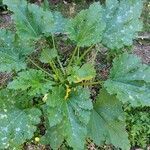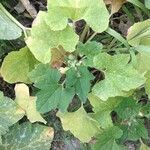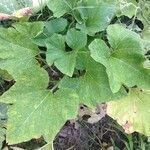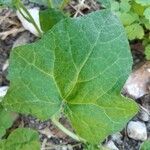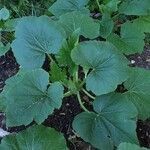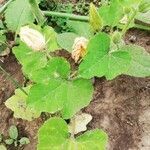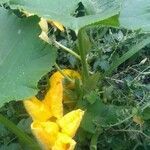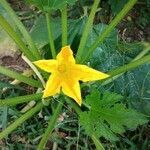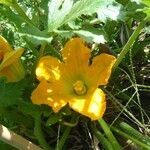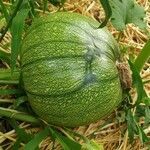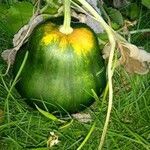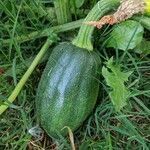A bristly hairy annual vine in the pumpkin family. It has branched tendrils. The stems are angular and prickly. The leaves are roughly triangular. The leaves have 5 lobes which are pointed at the end and are toothed around the edge. Male and female plants are separate on the same plant. Male flowers are carried on long grooved flower stalks. Female flowers are borne on shorter more angular stalks. The fruit stalks have furrows along them but are not fattened near the stalk. The fruit vary in shape, size and colour. Often they are oval and yellow and 20 cm long by 15 cm wide. The seeds are smaller than pumpkin and easy to separate from the tissue. The scar at their tip is rounded or horizontal, not oblique. There are a large number of cultivated varieties.
Plants climbing. Stem setose and scabrous-hairy. Petiole setose, 6-9 cm; leaf blade triangular or ovate-triangular, both surfaces scabrous-hairy, base cordate, margin irregularly dentate, apex acute. Tendrils many fid. Plants monoecious; flowers solitary; pedicel angular, 3-6 cm, yellow-brown setose; calyx tube 5-angled; segments linear-lanceolate; corolla campanulate, ca. 5 × 3 cm; segments erect, apex acute; stamens 3; filaments ca. 15 mm; anthers connivent, ca. 10 mm; ovary ovoid, 1-locular. Fruiting pedicel robust, conspicuously angular-sulcate, apex slightly thickened; fruit variable in shape and size. Seeds numerous, white, ovate, ca. 20 mm, marginate and obtuse. Fl. and fr. May-Nov.
Plant, including leaves, rigid or scabrous, in certain cultivated varieties bushy and not trailing. Leave blades often deeply acutely lobed, lobes often lobulate. Flowers: pedicel subangular; receptacle-tube campanulate; sepals linear in male and female flowers; corolla lobes slightly out-curved. Fruit small, medium or very large, smooth, sometimes costate or verrucate; fruit pulp sometimes fibrous; fruiting pedicel rather slender, woody, angular (sulcate), not or only little thickened at the transition to the fruit. Seeds variable in size, 7-25 mm long.
